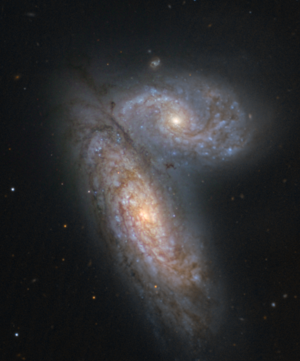Astronomy:NGC 4567 and NGC 4568
| NGC 4567 and NGC 4568 | |
|---|---|
 The Butterfly Galaxies with NGC 4567 (top) and NGC 4568 (bottom) | |
| Observation data (J2000.0 epoch) | |
| Constellation | Virgo |
| Right ascension | 12h 36m 34.3s |
| Declination | +11° 14′ 17″ |
| Distance | 62 Mly (19.1 Mpc)[1] |
| Apparent magnitude (V) | +10.9 |
| Absolute magnitude (V) | -13.3 |
| Characteristics | |
| Type | SA(rs)bc / SA(rs)bc |
| Apparent size (V) | 4.6′ × 2.1′ |
| Notable features | colliding galaxies |
| Other designations | |
| NGC 4567/8, UGC 7776/7, PGC 42064/9, VV 219,[2] KPG 347,[3] Butterfly Galaxies,[4] Siamese Twin Galaxies, Siamese Twins Galaxies, Siamese Twins[5][NB 1] | |
NGC 4567 and NGC 4568 (nicknamed the Butterfly Galaxies[4] or Siamese Twins[NB 1][5]) are a set of unbarred spiral galaxies about 60 million light-years away[1] in the constellation Virgo. They were both discovered by William Herschel in 1784. They are part of the Virgo Cluster of galaxies.
These galaxies are in the process of colliding and merging with each other, as studies of their distributions of neutral and molecular hydrogen show, with the highest star-formation activity in the part where they overlap. However, the system is still in an early phase of interaction.[6] In about 500 million years the galaxies will coalesce into a single elliptical galaxy.[7]
Four supernovae have been observed in the Butterfly Galaxies: SN 1990B (type Ib, mag. 16),[8] SN 2004cc (type Ic, mag. 17.5),[9] SN 2020fqv (type IIb, mag. 19),[10] and SN 2023ijd (type II, mag. 16.8).[11]
Naming controversy
The two galaxies were nicknamed "Siamese Twins" because they appear to be connected. On August 5, 2020, NASA announced that they would not use that nickname in an effort to avoid systemic discrimination in their terminology.[12][13]
See also
Notes
References
- ↑ 1.0 1.1 "Distance Results for NGC 4568". NASA/IPAC Extragalactic Database. http://nedwww.ipac.caltech.edu/cgi-bin/nDistance?name=NGC+4568.
- ↑ "VV 219 -- Interacting Galaxies". SIMBAD. http://simbad.u-strasbg.fr/simbad/sim-id?Ident=vv219&submit=submit+id.
- ↑ "KPG 347 -- Pair of Galaxies". SIMBAD. http://simbad.u-strasbg.fr/simbad/sim-id?Ident=kpg347&submit=submit+id.
- ↑ 4.0 4.1 Cong Xu; Yu Gao; Joseph Mazzarella; Nanyao Lu; Jack W. Sulentic; Donovan L. Domingue (2000). Mapping IR Enhancements in Closely Interacting Spiral-Spiral Pairs. I. IS0 CAM and IS0 SWS Observations. 10.1.1.317.8256.
- ↑ 5.0 5.1 Cudnik B. (2013). "The Nature of Galaxies and Galaxy Clusters". Faint Objects and How to Observe Them. Astronomers' Observing Guides. Springer. pp. 71–91. doi:10.1007/978-1-4419-6757-2_4. ISBN 978-1-4419-6756-5.
- ↑ Kaneko, H.; Kuno, N.; Iono, D.; Tosaki, T.; Sawada, T.; Nakanishi, H.; Hirota, A. (2010). "Molecular Gas in the Early Stage of Interacting Galaxies: The NGC 4567/8 Pair". Galaxy Wars: Stellar Populations and Star Formation in Interacting Galaxies 423: 26. Bibcode: 2010ASPC..423...26K.
- ↑ https://noirlab.edu/public/images/noirlab2219a/
- ↑ Transient Name Server entry for SN 1990B. Retrieved 30 March 2023.
- ↑ Transient Name Server entry for SN 2004cc. Retrieved 30 March 2023.
- ↑ "SN 2020fqv". Transient Name Server. https://wis-tns.weizmann.ac.il/object/2020fqv.
- ↑ Transient Name Server entry for SN 2023ijd. Retrieved 14 May 2023.
- ↑ Haworth, Jon (August 9, 2020), "NASA drops 'insensitive' celestial nicknames in effort to address systemic discrimination", ABC News, https://abcnews.go.com/US/nasa-drops-insensitive-celestial-nicknames-effort-address-systemic/story?id=72266188, retrieved 2020-08-10
- ↑ https://www.nasa.gov/solar-system/nasa-to-reexamine-nicknames-for-cosmic-objects/
External links
- Kopernik Space Images, Spiral Galaxies NGC 4568 and NGC 4567 aka "The Siamese Twins" : Supernova 2004cc, George Normandin (29 June 2004)
- Skyhound, The Siamese Twins
- SIMBAD, VCC 1673 : NGC 4567 -- Galaxy in Pair of Galaxies
- SIMBAD, VCC 1676 : NGC 4568 -- Galaxy in Pair of Galaxies
- NED, VV 219
- NED, NGC 4567
- NED, NGC 4568
 |


